…for several of my friends. They all got redeemed, apart from one. I keep reminding the guy, but he never gets around to redeeming it, so I reckon he doesn’t want it.
So: if you want it, it’s yours. Just PM me your Steam username.
Gone! To Swiisha.
Dan Q
This self-post was originally posted to /r/playitforward. See more things from Dan's Reddit account.
…for several of my friends. They all got redeemed, apart from one. I keep reminding the guy, but he never gets around to redeeming it, so I reckon he doesn’t want it.
So: if you want it, it’s yours. Just PM me your Steam username.
Gone! To Swiisha.
You may remember the long-running story of my letters to the Office of National Statistics, and the more-concentrated effort by another blogger, in regard to the automatic “correction” of supposedly-“erroneous” data in the 2011 census, like somebody having multiple partners or identifying as neither gender. You don’t? Well here’s a reminder: part one, part two, part three, part four.
Well: we’ve finally had some success. A response has been received from the ONS, including – at last – segments of business logic from their “correction” code.
It’s hard to tell for certain what the result of the correction will be, but one thing’s for sure – Ruth, JTA and I’s census data won’t have passed their validation! Their relationship validations BP2, BP2a, and BP2b state that it is logically-impossible for a person to have a spouse and a partner living with them in the same household.
I should invite them around for dinner sometime, and they can see for themselves that this isn’t true.
I also note that they consider it invalid for anybody to tick both or neither of the (two) gender option boxes, although again, it’s not clear from the data they’ve provided how the automatic correction occurs. Increasingly, I’m coming to suspect that this might actually be a manual process, in which case I’m wondering what guidelines there are for their operators?
One good piece of news from this FoI request, though: the ONS has confirmed that the original census data – the filled-in paper forms, which unlike the online version doesn’t enforce its validation upon you – is not adjusted. So in a hundred years time, people will be able to look back at the actual forms filled in by poly, trans, and other non-standard households around the UK, and generate actual statistics on the frequency with which these occur. It’s not much, but it’s something.
It’s that time again, the highlight of the interactive fiction year (for me, at least), and IFComp 2011 is upon us. I’ve been playing my way through this year’s entries, and – as I have in previous years – I’ll be sharing with you any that leap out at me as “things you really ought to try.”
The first of which is The Play, by Deirdra Kiai. This entry stands out for a few reasons. Firstly, it’s one of those uncommon (but growing in popularity) pieces of hypertext IF. I remain not-completely convinced by hypertext IF: perhaps as a result of the medium, the games often feel shorter than they might otherwise be, and while I don’t miss playing “hunt the verb” to try to find exactly the word the designer hoped I would, having the option to click on any one of just a handful of links seems a little… simple.

That’s not to say that I don’t like the medium: hell, I feel like I was a pioneer in it, thanks to things like Troma Night Adventure (originally on the long-dead RockMonkey Wiki, and revived in its own engine last year). It’s just… different from most IF that I play, and that difference is stark.
If there’s one big advantage to hypertext interactive fiction, though, it’s that it lowers the barrier to entry. Everybody knows how to use a web browser, there’s nothing to install or set up, and they typically play really well on mobile devices, which is a growing market for this kind of game. I’m excited to see tools like Twine/Twee, ChoiceScript, and Undum (the latter of which powers The Play) appearing, which make creating this kind of game reasonably easy.
Secondly; it’s unusual. And I do enjoy a bit of quirky fiction: something that takes the genre in a new direction. And The Play does that. You play as Ainsley M. Warrington, the director of a disaster-ridden play on the eve of the first night, orchestrating a last-second dress rehearsal. The story is told through alternating segments of your experience and “script”: segments of the play as they are performed (which may vary, depending on how lenient you allow the cast the be with the script and how much goes awry), and this is a wonderful use of the semi-graphical nature of the medium.
Mostly, you’re trying to balance and improve the moods of your cast members (and your stage manager), in order to gain a good review. This is made challenging by the fact that they all have quite different ideas and attitudes towards the nature of the play, how it should be performed, and so on. They only thing that they all seem to agree on is that you’re not doing a very good job.
But beyond that theoretical (and, frankly, self-imposed) goal, it’s actually a lot of fun just to play off the different actors against one another, to experiment with how much you can improvise the ending, and to see how things turn out if you try different choices. And that’s exactly how interactive fiction ought to be. Like a good book, I want to be able to read it again and again. But unlike traditional fiction, I can enjoy it in profoundly different ways based on my moods and whims.
It’s a little short, but quite beautiful for it. There’s certainly plenty of reasonably well-written text to amuse and entertain. I’d thoroughly recommend that you give it a go, whether you’re an IF veteran or if you’ve never played this kind of game before in your life: play The Play in your web browser. And then play it again to see how much of a difference you can make in this well-crafted and inspiring little world.
It’s asexual awareness week. Go hug an asexual.
Or, if you’ve not got any asexual people around you, that you’re aware of (remember, though, that some asexuals are closeted), here’s a special mission for you:
While asexual people don’t face the same kind of discrimination as other minority sexualities (for example, I’ve never heard of “a-bashing”), they’re still widely-misunderstood and often asked stupid questions like “How do you know you don’t like sex if you’ve never tried it?” (if you don’t know why that’s a stupid question, I refer you to the aforementioned FAQ)
So yeah: go hug an asexual today. In a non-sexual way, I’d suggest.
Next week is half-term. Why does that matter? Because I’m back in education.
Since last month, I’ve been a student again. Not full-time (I’m not falling for that one again), of course, but I currently spend my Monday evenings studying towards a Certificate in Counselling Skills at Aylesbury College.

It’s actually a qualification I’ve been looking at for several years, but it’s only recently that I’ve lived somewhere even remotely close to somewhere that it’s taught: while there’s a lot of counselling theory that can be learned by distance learning, there’s naturally a lot of hands-on counselling practice that demands a classroom or clinical setting, and for that… you really do need to be within reach of a suitable school.
Not that Aylesbury‘s exactly on my doorstep. It’s not even in the same county as me (it’s just barely over the border, in fact, into Buckinghamshire). And this can make things a little challenging: whereas many of my classmates walk or cycle in, I have a special little dance that I have to do every Monday, in order to make my study possible.
I arrive at work early, so that I can get out of the door by 4:30pm. I then leap onto my bike and pedal furiously through Oxford’s crowded afternoon streets to the East side of the city. There, I lock my bike up and hop into a borrowed car (more about that in another blog post), pick my way out between the growing pre-rush-hour traffic, sprawling 20mph zones, and deathwish cyclists, and hammer along the A418 in order to get to class for its 6pm start.

Three hours of theory and roleplay later (as well as a break to eat a packet sandwich), I’m back on the road. It annoys me more than a little that now that I’m not in a hurry, the roads are usually clear and empty, but it’s a good excuse to crank up the volume on Jack FM and enjoy the ride back through the villages of East Oxfordshire. Back in Oxford, I pick up my bike and cycle home: I’m usually back before 10:30. It’s quite a long day, really.
So what’s it all for? Well: ultimately, if I stick with it, it leads to a Certificate in Counselling, then to a Diploma in Counselling. If you take that and couple it with a stack of distance learning modules, it adds up to… well, this Foundation Degree in Counselling, perhaps.
But that’s not what you wanted to know: what you wanted to know was, “What are you doing, Dan? What’s wrong with the degree and career you’ve already got?”
Well firstly, of course, learning doesn’t have to be about qualifications. This is a field that I’ve been interested in for longer than I’ve been blogging. Plus: I’m sure that my various pieces of emotional support work, like my work with Oxford Friend, will benefit from the experience and learning that I bring to it.
But also, it’s about the idea I’ve always had that a good mid-life crisis ought to benefit from planning: it’s too important to leave to chance. And I’ve been thinking that a career switch might be a great mid-life crisis. The social sciences are fun, and while counselling might not be exactly what I’m looking for, there’s some doors opened by studying it. With less than a decade before I’m 40, and with part-time study being an ever-so-slow way to get things done, I’d better pull my finger out.
Doubtless, I’ll have more to say about my course as it progresses, but for now, I’m just glad that it’s half-term week, which means I get a week in which I don’t spend my Monday running around like a headless chicken… and I get twice as long to finish my homework.
This link was originally posted to /r/tabletopgamedesign. See
more things from Dan's Reddit account.
The original link was: http://www.spielmaterial.de/english/
There’s something that I just don’t understand about vegetarians. It’s something that I didn’t understand when I mercilessly teased them, and it’s something that I still don’t understand now that I am one:
What’s with the fake meat?

You know the stuff I’m talking about: stuff made out of mycoprotein or TVP or soya that’s specifically designed to emulate real meat in flavour (sometimes effectively) and texture (rarely so). Browse the chilled and frozen aisles of your local supermarket for their “vegetarian” section and you’ll find meatfree (although rarely vegan) alternatives to chicken, turkey, beef and pork, presented here in descending order of how convincing they are as a substitute.

Let’s be clear here: it’s not that I don’t see the point in faux meat. It has a few clear benefits: for a start, it makes vegetarianism more-approachable to omnivores who are considering it for the first time. I’ve tried meat substitutes on a number of occasions over the last couple of decades, and they’ve really improved over that time: even a meat-lover like me can be (partially) placated by the selection of substitutes available.

And while I slightly buy-in to the argument that the existence of these fake meats “glorifies” meat-eating, perhaps even to the extent as to under-sell vegetarianism as a poor substitute for the “real thing”, I don’t think that this is in itself the biggest problem with the fake meat industry. There’s a far bigger issue in question:
Why are we stopping here?

If we’re really trying here to make “fake meats”, then why are we setting our targets in-line with the commonly-eaten “real meats”? Why stop at chicken and turkey when we might as well make dodo-flavoured nut roasts and Quorn slices? Sure, they’re extinct, so we’ll probably never have real dodo meat: but there’s no reason that the manufacturers of artificial meats can’t have a go. There are dozens of accounts of the preparation and consumption of dodos, so we’d surely be able to emulate their flavour at least as well as we do the meats that we already produce substitutes for.

Why stop there? We might as well have tins of unicorn meat, too, a meal already familiar to those of us who’ve played more than our fair share of NetHack. How about dragons, or griffins, or the Vegetable Lamb of Tartary? If we’re going to make it up as we go along when we make artificial bacon, we might as well make it up as we go along when we make basilisk-burgers and salamander-sausages, too.
There’s a reason, of course, that we don’t see these more-imaginative meat substitutes. Many of the most loyal fake-meat customers are the kinds of people who don’t like to think about the connection between, for example, “chicken” (the foodstuff), and “chicken” (the clucking bird). To be fair, a lot of meat-eaters don’t like to think about this either, but I get the impression that it’s more-common among vegetarians.
But seriously, though: I think they’re missing a trick, here. Who wouldn’t love to eat artificial pegasus-pâté?
Looking Back
On this day in 1999 I sent out the twelfth of my Cool Thing Of The Day To Do In Aberystwyth e-mails. I wasn’t blogging at the time, although I did have a blog previously, but I felt that it would be nice to do something to help keep in touch with my friends and family “back home”, so I came up with Cool Thing Of The Day To Do In Aberystwyth. I’ve written about it a little in a previous On This Day post.
On this particular day, I’d just finished downloading a copy of The Matrix, that fantastic cyber/action movie that spawned a huge string of memes and won the love and praise of geeks and action-flick junkies everywhere. The movie remains a pinnacle of great filmmaking, with its’ adventurous direction (remember when bullet time was still new and exciting?), funky soundtrack, and cleverer-than-average twists… for a film full of guns.
I’d not been at the University long, and I was making the most of the huge amount of bandwidth that seemed to be available: for the first time ever, I was able to download music (of a appreciable bitrate) faster than I could listen to it (the boundary at which “streaming” becomes feasible). Unfortunately, I hadn’t yet splashed out on new hardware, so downloading a 1.4GB film quickly became a drain on my hard drive, which will have probably been in the region of about 20GB total. But it didn’t matter, because it was cool. “Look at me, I’m a l33t haxxor like Neo!” I never actually uttered those words, but I might as well have.
I soon went and bought a copy of The Matrix – one of the first DVDs I owned – if only to save on hard drive space. I also burned my second ever student loan cheque on a beefy new computer of a specification so high that nobody I knew had even seen such a thing before: including a massive 500MHz processor (or as we’d call it nowadays, a “half-gigahertz”).
Later, friends and coursemates Rory, Huw, John, Dom would join me in producing a 15-minute spoof of The Matrix as part of our entry for the University of Wales, Aberystwyth’s Student Skills Competition. We won best presentation. This in gave me the opportunity to help out with the Student Skills Competition and networked me to the person who eventually introduced me to the guy who would eventually become my boss at SmartData. It’s amazing how these little things link together, isn’t it?
Looking Forward
Later still, no sequels were made to The Matrix, thankfully. You heard me: no sequels were made. Especially not Reloaded. Okay, okay: they made The Animatrix. But they certainly didn’t make any video games.
Nowadays, I keep a little over 2TB of storage space in my primary computer, but I still manage to fill it somehow – one of my drives ended up with only 5GB of free space just the other month, and needed a big tidy-up. Or, as they’ll call it in another twelve years: 0.00005PB.
This blog post is part of the On This Day series, in which Dan periodically looks back on years gone by.
This link was originally posted to /r/Minecraft. See more things from Dan's Reddit account.
The original link was: https://www.youtube.com/watch?v=8B8jRMMkCyo
The Treasures of the Bodleian exhibition opened today, showcasing some of the Bodleian Libraries‘ most awe-inspiring artefacts: fragments of original lyrics by Sappho, charred papyrus from Herculaneum prior to the eruption of Mt. Vesuvius in 79 CE, and Conversation with Smaug, a watercolour by J. R. R. Tolkien to illustrate The Hobbit are three of my favourites. Over the last few weeks, I’ve been helping out with the launch of this exhibition and its website.
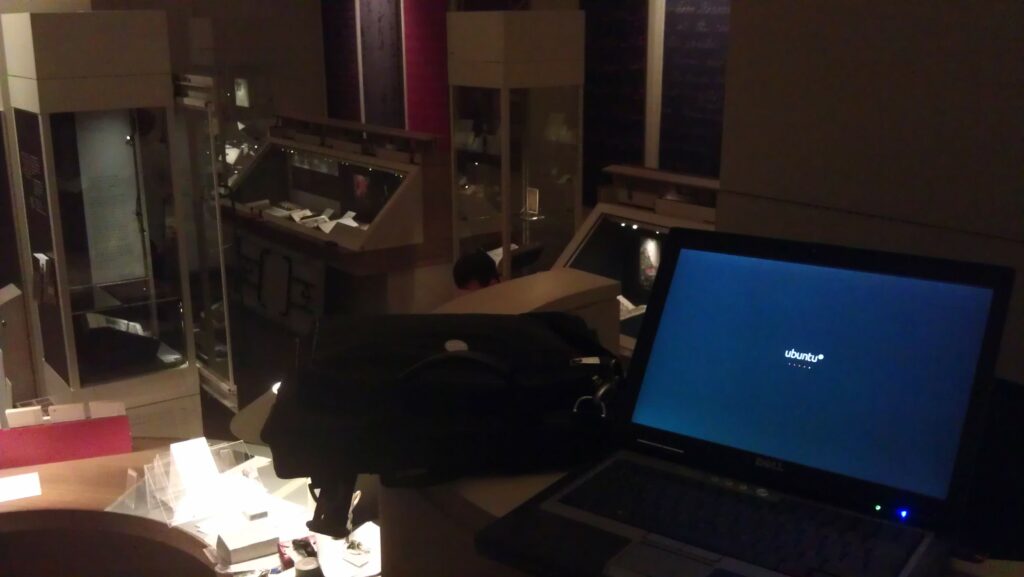
In particular, something I’ve been working on are the QR codes. This experiment – very progressive for a sometimes old-fashioned establishment like the Bodleian – involves small two-dimensional barcodes being placed with the exhibits. The barcodes are embedded with web addresses for each exhibit’s page on the exhibition website. Visitors who scan them – using a tablet computer, smartphone, or whatever – are directed to a web page where they can learn more about the item in front of them and can there discuss it with other visitors or can “vote” on it: another exciting new feature in this exhibition is that we’re trying quite hard to engage academics and the public in debate about the nature of “treasures”: what is a treasure?

In order to improve the perceived “connection” between the QR code and the objects, to try to encourage visitors to scan the codes despite perhaps having little or no instruction, we opted to embed images in the QR codes relating to the objects they related to. By cranking up the error-correction level of a QR code, it’s possible to “damage” them quite significantly and still have them scan perfectly well.

We hope that the visual association between each artefact and its QR code will help to make it clear that the code is related to the item (and isn’t, for example, some kind of asset tag for the display case or something). We’re going to be monitoring usage of the codes, so hopefully we’ll get some meaningful results that could be valuable for future exhibitions: or for other libraries and museums.
Rolling Your Own
If you’re interested in making your own QR codes with artistic embellishment (and I’m sure a graphic designer could do a far better job than I did!), here’s my approach:
https://chart.googleapis.com/chart?chs=500×500&cht=qr&chld=H|0&chl=HTTP://TREASURES.BODLEIAN.OX.AC.UK/T7
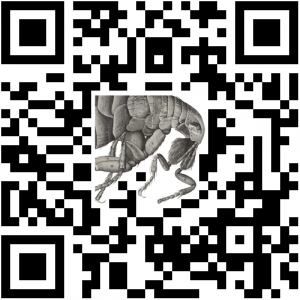
Give it a go! Make some QR codes that represent your content (web addresses, text, vCards, or whatever) and embed your own images into them to make them stand out with a style of their own.
This was one of my most-popular articles in 2011. If you enjoyed it, you might also enjoy:
Just a quick thought: what does it say on the inside front cover of the Queen‘s passport?

Presumably it ought to say:
My Secretary of State requests and requires in my name all those whom it may concern to allow the bearer to pass freely without let or hindrance, and to afford the bearer such assistance and protection as may be necessary.
Nonetheless, I’ll bet that she doesn’t get as much trouble at passport control as I do, despite the fact that she doesn’t have a surname at all (to be completely accurate, Windsor is the name of her royal house, and is not a surname in the conventional sense). It makes the Passport Office look a little silly to complain about my unusually short name.
Interesting fact about passports: in their current form, they’re a comparatively new invention, but have achieved a rather quick ubiquity in international travel. Historically, the term “port” in their name doesn’t refer, as you’d expect, to sea ports, but instead to the “portes” (gates) of walled cities: most early passports granted the bearer the permission of their lord or monarch to travel between cities in their own country – sea ports and international boundaries were considered fair game for anybody to cross.
It was only really with the outbreak of the First World War that it became a widespread mandate that travellers had passports to cross international borders, as the nations of Europe fought to prevent spies. The Schengen Area – only around 25 years old and hailed as welcome liberalisation of European international transit laws – could actually be likened to a step backwards to a simpler time when citizens movements were not so closely monitored.
Recently, I’ve been diagnosed with cluster headaches. I could tell you more about them, but I’d rather just point you at the Wikipedia article and say “that’s pretty much spot on.”

So that’s pretty shit.
It’s been several months now – long enough that, to begin with, I suspected that these new, severe headaches were something to do with the concussion I suffered while moving house. I’m still not convinced that they’re not: it just seems a little too much like a coincidence that that’d happen just weeks before they started.
Since then, they’ve come and gone. Attacks will come on every couple of days – usually at about 3am, but sometimes in the afternoon – for about two weeks, and then will be gone for several weeks. And then they come back again.
The pain is… incredible. I can’t even begin to describe it nor compare it to anything else. Painkillers don’t seem to touch it at all. The only success I’ve had with painkillers has been when I’ve taken so much codeine that I’ve had an “opium high”. The pain doesn’t go away, but at least then I don’t care so much. Then within a couple of (long, long) hours, it’s gone, leaving me drained and exhausted. Sometimes it leaves me with a headache – just a “normal” one, the kind that you can wince and ignore, or treat with asprin – for about a day afterwards, but usually it just disappears as quickly as it came on.

I’ve been working my way through a variety of medications, with limited success. Basically, the doctors are guessing. In sheer desperation, I’ve even been caught using mild-to-moderately ridiculous alternative treatment, like chiropractic. It didn’t work – it just left me with a new variety of back pain: temporary, I hope – but I think it goes some way to expressing how crippling it is when I of all people will go to a “spine wizard”. Needless to say, I’m still a long way from desparate enough to try the really stupid alternative medicines: it’s still got to at least sound like it might work before you’ll get me to try it – after all, it’s not like any of these therapies are without risks.
There’s next to no build-up, and no warning, and no relief: they just start and go away their own accord. That’s a terrifying feeling of powerlessness. It’s genuinely scary, going to bed during one of their episodic periods, and not knowing if you’re going to wake up in agony a few hours later.
We’re getting somewhere, though, hopefully. I’ve been assigned to a specialist (to whom I’m sure I’ll be as much a research subject as a patient: I suppose it’s pretty ideal – if you have a rare, barely-understood disease and you’re at the point of being willing to try anything, you probably make a great research subject), and in the meantime there are plenty more medications left to “try”. And I’ve been reading some of the thoughts of other sufferers via an online support group, some of whom have shared some of their relief/coping strategies (some of which I’ve tried already; others of which I’ll try in the future). So there’s still plenty of opportunity for a “fix”.
I didn’t blog about this before now because I was hoping to get to a point where I’d be looking back on it and laughing, first. I quite liked the idea of putting up a blog post – perhaps with some photos of my MRI scans, or something – and saying “Hey; look what happened to me! It’s medication-controlled, now, and the only side-effect is that I can shoot frickin’ laser beams out of my eyes! Muhahahaha!” But I guess that point might still be a way away, and I didn’t want to keep you all in the dark.
Anyway: there’s that, then. If you were hoping for a clean, concise blog post with some closure at the end, you’ll be left hanging. But hey: if I have to suffer, I might as well spread a little bit of suffering to you, too.
Another successful murder mystery party! This one was a prefabricated “kit” one, unlike many of our recent ones, in the Inspector McClue range.
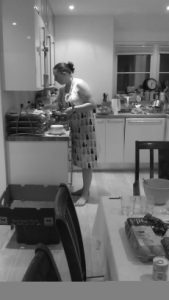
I was slightly worried that – with only six people (we four Earthlings and Ruth‘s brothers) in attendance, that the evening might be a little too “quiet”, but Robin and Owen did a pretty good job of ensuring that this wasn’t the case by any stretch of the imagination.
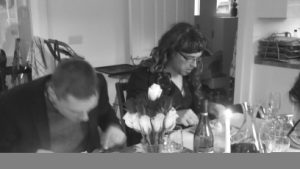
My character was Marlene Deepditch, a German wine merchant. Not wanting to take things by halves, I put a perhaps-excessive amount of effort into my last-minute costume, even going so far as to shave off my beard… as well as my sideburns… chest… armpits…

The night yielded three surprises:
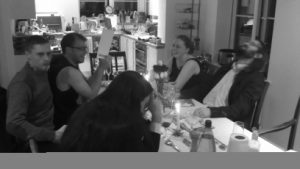
All in all, a fantastic night, full of exactly the kind of delicious chaos that’s usually reserved for larger murder mystery parties – watch this YouTube video (may contain spoilers) to see what I mean.
Never before have I come across a wine so obviously created for me as this one.

I haven’t tasted it, and I’ve never seen it for sale. But just look at the label: it’s called pro-mis-Q-ous, a deliberate mis-spelling of “promiscuous” that substitutes in and emphasises the letter Q (which, of course, is my surname). The label goes on to define promiscuity, and it – and their website, makes significant mention on nonmonogamy, which few will by surprised to hear is pretty close to my heart too.
What a great name. I wish I’d come up with it.